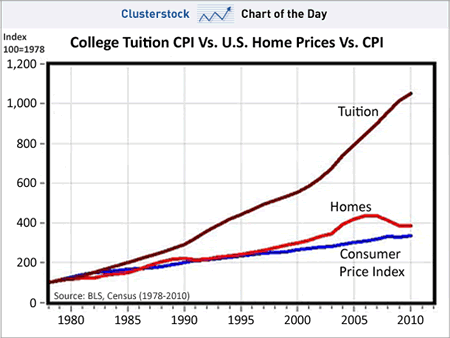Federal Education Aid and Higher Education Inflation - There is a Connection
Increased availability of student loans should theoretically make college more affordable, but research has proven government lending to be grossly counterproductive. Though these programs attempt to make school more accessible to people of low income, they have defeated their intended purpose by driving tuition costs up exponentially. Initially, banks refused to offer loans to college students, because young adults typically lack any substantial assets or collateral. The abnormal nature of this market eventually led to government involvement in funding of higher education, but with many unintended consequences. Universities race to absorb the greatest portion of federal funding by raising tuition costs. This research builds upon the Bennett Hypothesis, an idea circulated in the 1980s by U.S. Secretary of Education William J. Bennett. Many factors play a role in the convoluted issue of spiked tuition costs, but a strong case can be made for the Bennett Hypothesis. [Federal funding directs tuition, The Daily Evergreen, September 28, 2010]Beginning with the Higher Education Act of 1965, the federal government ... has provided significant funding to help ensure that low- and moderate-income students and families are not prevented from receiving a postsecondary education simply because of financial circumstances. This year, thanks to the Education Act, roughly $90 billion [was invested] in higher education, with the bulk of that money, about $65 billion, [going] directly to students. On the supply side, this federal aid makes universities less sensitive about their own costs. "Increases in financial aid in recent years have enabled colleges and universities blithely to raise tuition, confident that Federal loan subsidies would help cushion the increase," then-Secretary of Education William J. Bennett said in 1987. The "Bennett hypothesis" -- the theory that as long as the government ensures the bills will get paid, colleges will raise tuition -- makes sense, especially in light of Washington's guarantee of an affordable college education for all who want one. [The Tuition Aid Trap, The Cato Institute, October 9, 2003]
The more the government subsidizes tuition, the higher tuition rises. These are the same institutions that teach our young that capitalism is bad and that socialism is good while continuing to raise the tuition. They have the best of both worlds -- they use the capitalistic system to justify raising tuition and depend on the socialistic system to get the subsidies from the government (taxpayers) to continue to raise tuition to line their own pockets.According to economist Richard Vedder, college tuition costs increased by 295 percent between 1982 and 2003, a growth rate higher than health care costs (195 percent), housing (84 percent), and all items (83 percent). In his book, "Going Broke By Degree: Why College Costs Too Much," Dr. Vedder argues that increased federal spending on higher education has contributed to rising tuition costs. In other words, federal subsidies are not making higher education more affordable because colleges and universities simply consume this additional source of revenue. [The Facts on Federal Education Spending, The Heritage Foundation, November 9, 2006]
The US House of Representatives passed new legislation last week that Democratic majority leaders claim is the largest college student aid package since the 1944 GI Bill. In reality, the College Cost Reduction Act of 2007 will do little to alleviate the financial burden for millions of college students who are confronting skyrocketing tuition costs and a crushing level of student loan debt. While the GI Bill provided tens of billions to enable returning veterans to attend college, the Democrat-sponsored bill does not propose any new actual spending. Instead, small increases in student aid will be paid for by cutting $19 billion in federal subsidies to the student loan industry over the next five years. College costs—including tuition, fees, books, materials and living expenses—have outpaced inflation by nearly 40 percent over the last five years. The College Cost Reduction Act will do nothing to stop the single most important cause of rising student costs: ever-increasing tuition rates. Throughout the country, colleges and universities continue to raise rates, in large measure due to a reduction in state funding. [House passes meager “College Cost Reduction Act,” Tuition rates continue to skyrocket at US colleges, World Socialist Web Site, July 18, 2007]
Student loan debt is more of a financial drain on Americans than ever before. Americans now owe more on student loans than they do on credit cards. As hard as that is to believe, that is actually true. Americans now owe more than $849 billion on student loans, which is a new all-time record. [75 Ways That the Government and the Financial Elite Will Be Sucking Even More of the Life Blood Out of the American People In 2011, The Economic Collapse Blog, October 23, 2010]
This chart from Clusterstock (via Carpe Diem) shows the cost of college tuition comparison to historical housing prices and the Consumer Price Index (CPI) over the same period. The CPI is designed to track our cost of living by estimating the average price of consumer goods and services purchased by households. Everything was normalized to 100 starting in 1978. While housing went up 4x at its peak (~400), college tuition has gone up over 10x. [Charts: College Tuition vs. Housing Bubble vs. Medical Costs, My Money Blog, August 31, 2010]






No comments:
Post a Comment